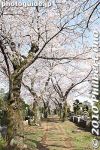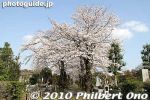 Image search results - "graves" Image search results - "graves" |

Entrance to Iimoriyama Hill, site of the Byakkotai "White Tiger" Battalion gravesite. In 1868, a unit of teenage warriors called Byakkotai (White Tiger Battalion) fought against the Emperor-backed Imperial forces encroaching their domain of Aizu
|
|

The Byakkotai were outnumbered and forced to retreat. Twenty of them escaped to Iimoriyama Hill where they saw what looked liked a burning Tsurugajo Castle. Photo: Pay a small fee to take the escalator up the hill. Or climb up the steps for free.
|
|

In despair, the boys decided to kill themselves rather than die in the hands of the enemy. Photo: Escalator to go up Iimoriyama Hill.
|
|

Escalator to go up Iimoriyama Hill. Their tombstones are on this hill near where they killed themselves. Their story has become legend.
|
|

Byakkotai Gravesite. It is on a flat area which also has several other Byakkotai monuments including those from other countries.
|
|

Approach to the Byakkotai gravesite.
|
|
|

Graves of the 19 teenage Byakkotai warriors who killed themselves with their own swords.
|
|

Byakkotai Graves
|
|

Byakkotai Graves
|
|

Byakkotai gravestones. Each one shows the name, age, and method of death called "jijin" (died with one's own sword 自刃).
|
|
|

This has become a national shrine, almost as important as Sengakuji where the 47 masterless samurai are buried.
|
|
|
|
|

On the right side are more gravestones. These are 31 Byakkotai members who died in battle. 戦死
|
|

Tombs of those Byakkotai who died in action.
|
|

Tombs of those Byakkotai who died in action.
|
|

Their names, age, and "senshi" 戦死 (died in battle) are engraved on the stones.
|
|
|
|

Monument for teenage samurai who died in battle.
|
|

Names of Byakkotai members, all 14 to 17 years old.
|
|

On the left of the gravestones, there is a monument for a poem composed by Lord Matsudaira Katamori, the last Aizu lord and whom the Byakkotai died for. 幾人の 涙は石にそそぐとも その名は世々に 朽じとぞ思う幾人の 涙は石にそそぐとも その名は世々に 朽じとぞ思う
Ikutari no namida wa ishi ni sosogu tomo sono na wa yoyo ni kuji to zo omou
"No matter how many people pour their tears on these stones, these names will never fade from the world."
|
|

A short walk away is the grave of Iinuma Sadakichi, the only Byakkotai survivor who had slit himself, but was rescued by a villager passing by when everyone else had killed themselves.
|
|

Grave of Iinuma Sadakichi, the only Byakkotai warrior who survived and told the story of this valiant teenage group.
|
|

Grave of Iinuma Sadakichi (Sadao) (1854-1931). His grave was built here in 1957 for the 90th anniversary of the Byakkotai's demise. 飯沼貞吉
|
|

About Iinuma Sadakichi (later changed his first name to Sadao)
|
|

Slope where they committed seppuku (hara-kiri). 自刃の地
|
|

Site where they committed seppuku (hara-kiri). 自刃の地
|
|
|
|
|
|
|
|
|

A recent addition is this statue of a teenage samurai looking at Wakamatsu Castle.
|
|

Statue of a teenage samurai looking at Wakamatsu Castle.
|
|
|

Statue faces Tsuruga-jo Castle which can be seen in the distance.
|
|

Arrow points to Tsuruga-jo Castle.
|
|
|

Byakko Kannon statue
|
|
|
|
|

Monument from Rome, Italy, given in 1928 by Mussolini. The column is from the ruins of a palace in Pompeii.
|
|

Monument message in Italian. After WWII, the US Occupation authorities wanted this monument removed. But all they did was remove the engraved message (later restored).
|
|

About the monument from Rome.
|
|

Monument from a German, Hasso von Etzdorf (1900 - 1989).
|
|

Another monument
|
|

Opened in 1956, the Byakkotai Memorial Museum has numerous artifacts related to the Byakkotai as well as the Shinsengumi. Photography inside is not allowed. Admission 400 yen.
|
|

Byakkotai statue outside the Byakkotai Memorial Museum
|
|
|
|

Way to the graves of Hojo Nakatoki and his men who committed suicide.
|
|

A few steps up a slope.
|
|

Memorial for Hojo Nakatoki and his men. They had lost to Ashikaga Takauji in the battle at Kyoto and were trying to escape to Kamakura, but was caught by Takauji's forces at Bamba.
|
|

Over 430 gravestones. Hojo Nakatoki and his men were besieged in Bamba by Southern Imperial Court forces. They fought back, but lost and slit their bellies in front of Rengeji's Hondo main hall.
|
|

The temple's third priest wrote the names and age (youngest was 14) of the known fallen warriors in a scroll. He also made these gravestones for them. Visuallly, it's very impressive edifice.
|
|

Graves of Hojo Nakatoki and his men from the Rokuhara Tandai. 北条仲時一行の墓
|
|

The gravestones have five levels. In fall, the surrounding maple leaves turn blood red.
|
|

There are more steps which lead to graves of temple priests and Saint Ikko's mausoleum.
|
|

Graves of previous temple priests.
|
|

Mausoleum of Saint Ikko Shunsho.
|
|

Small mausoleum for Saint Ikko. 一向上人の御廟
|
|

Way to Tama Cemetery. One of Tokyo's major cemeteries with the graves of celebrated figures including politicians, scholars, and novelists. Also a noted cherry blossom spot in spring.
|
|

Front entrance to Tama Cemetery.
|
|

Mitama-do Hall
|
|

The cemetery is basically in a grid pattern.
|
|

The main roads have cherry trees.
|
|
|

Tama Cemetery Fountain tower.
|
|
|
|
|

Memorial plaque in Japanese and English.
|
|
|
|
|
|

Empty grave plot.
|
|

Torii gate at this gravesite.
|
|
|
|
|
|
|
|
|
|
|
|
|
|
|
|
|
|

Cherry blossoms and graves at Tama Cemetery.
|
|
|
|

Elaborate grave sculpture.
|
|
|
|
|
|

Some of the best sakura trees are on this main road.
|
|
|
|

Cemetery map and sign.
|
|
|
|
|
|
|
|

Bus stop for JR Musashi-Koganei Station.
|
|

Way to cemetery. Six Hikone Castle lords, including Ii Naosuke, have graves here. Setagaya was the domain of the Ii clan who often worked in the Tokugawa government.
|
|

Straight ahead is the grave of Lord Ii Naotaka, the 2nd lord of Hikone Castle in Shiga Prefecture.
|
|

Turn left and you see this. Ii clan graves on both sides. Lord Ii Naosuke's grave is at the very end on the left.
|
|

Lord Ii Naosuke's grave is at the very end on the left.
|
|

Grave of Lord Ii Naosuke (1815-1860), the lord of Hikone Castle in Shiga Prefecture and Chief Minister of the Tokugawa Shogun's government. Gotokuji temple, Setagaya-ku, Tokyo. 井伊直弼の墓 豪徳寺
|
|

Only Ii Naosuke's grave has a sign explaining about him.
|
|

Grave of Lord Ii Naosuke (1815-1860), the lord of Hikone Castle in Shiga Prefecture and Chief Minister of the Tokugawa Shogun's government. Gotokuji temple, Setagaya-ku, Tokyo. 井伊直弼の墓 豪徳寺
|
|

Gravestone of Ii Naosuke.
|
|

Right side of Lord Ii Naosuke's grave.
|
|

Tree of white camellias grow about Lord Ii Naosuke's grave.
|
|

Grave of Lord Ii Naosuke's wife.
|
|
|

Grave of Lord Ii Naohide (1755-1789). He served as Tairo Chief Minister in the Tokugawa government. Gotokuji temple, Setagaya, Tokyo 井伊直幸
|
|

Grave of Lord Ii Naotaka's eldest daughter who donated a lot to the temple. 井伊直孝長女
|
|
|

Grave of Lord Ii Naotaka (1590-1659), 2nd lord of Hikone, Shiga. Gotokuji temple, Setagaya, Tokyo 井伊直孝
|
|

Grave of Lord Ii Naoyoshi (1727-1754), Gotokuji temple, Setagaya, Tokyo 井伊直禔
|
|

Grave of Lord Ii Naotsune (1693-1710), Gotokuji temple, Setagaya, Tokyo 井伊直恒
|
|

Grave of Lord Ii Naonori on right.
|
|

Grave of Lord Ii Naonori (1848-1904), Gotokuji temple, Setagaya, Tokyo 井伊直憲の墓
|
|

Six Jizo
|
|

About the Kyogoku Clan graves at Tokugen-in temple. It was Kyogoku Takatoyo, lord of Marugame in Shikoku, who in 1672 acquired the temple land and gathered all the Kyogoku graves scattered in the area to Tokugen-in.
|
|

Kyogoku Clan graves at Tokugen-in temple. Kyogoku Takatoyo, the 22nd Kyogoku Clan leader, renamed the temple Tokugen-in after the posthumous Buddhist name of his father Takakazu.
|
|

Layout of Kyogoku Clan graves at Tokugen-in temple. There is a lower level and an upper level of graves on a slope accessible by stairs. Although Ujinobu was the first to make it the clan's family temple, it was quite dilapidated by Takatoyo's t
|
|
|
|
|
|

Graves of the Tadotsu Clan (多度津藩), a branch of the Kyogoku who ruled in Marugame. From left to right, Kyogoku Takateru (高琢), Takakata (高賢), Takabumi (高文), Takayoshi (高慶), and Takamichi (高通).
|
|
|
|

Kyogoku clan graves
|
|

The first Kyogoku grave, that of Ujinobu, the founder of the Kyogoku Clan.
|
|

The first Kyogoku grave, that of Ujinobu, the founder of the Kyogoku Clan.
|
|
|
|

View from the upper level Kyogoku graves.
|
|

Graves of the Tadotsu Clan (多度津藩), a branch of the Kyogoku who ruled in Marugame. From left to right, Kyogoku Takateru (高琢), Takakata (高賢), Takabumi (高文), Takayoshi (高慶), and Takamichi (高通). National Historic Site
|
|

Epitaph 碑文
|
|

Graves of Kyogoku Takayoshi (京極 高美), Takatoo (京極 高迢), and Takamasa (京極高政). They were much less prominent.
|
|

Kyogoku Takatsugi and Kyogoku Takanori's (1718-1763) grave
|
|

Kyogoku Takanori (1718-1763) and Kyogoku Takanaka's (1754-1811) graves.
|
|

Kyogoku Takatsugu's grave.
|
|

Inside Kyogoku Takatsugu's grave.
|
|

Kyogoku Takatsugu's grave.
|
|

Kyogoku Takanori's (1718-1763) grave. He was the fourth lord of Marugame in Shikoku. 京極高矩
|
|

Kyogoku Takanaka's (1754-1811) grave. He was the fifth lord of Marugame in Shikoku. 京極高中
|
|

Two lesser graves for Kyogoku Tadataka (京極忠高) and Takakazu (京極高和), the eldest son of Takatsugu.
|
|

Grave of Kyogoku Takatoyo, second lord of Marugame in Shikoku. 京極高豊
|
|

Grave of Kyogoku Takamochi, third lord of Marugame in Shikoku. 京極高或
|
|

There are steps to go up the hill where there are more Kyogoku graves. These are for the older Kyogoku members, starting with the founder of the Kyogoku Clan.
|
|

The narrow upper level has 18 gravestones, starting with the first Kyogoku Clan leader Ujinobu on the right.
|
|

The first Kyogoku grave, that of Ujinobu, the founder of the Kyogoku Clan. 氏信
|
|

View from the hill.
|
|

Nakae Toju's gravestone (left) in Adogawa, Takashima. 藤樹先生墓所
|
|
|
|
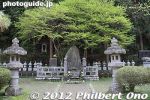
Graves of the Nihonmatsu Shonentai teenage samurai at Dairinji temple.
|
|

Graves of the Nihonmatsu Shonentai teenage samurai at Dairinji temple.
|
|

Graves of the Nihonmatsu Shonentai teenage samurai at Dairinji temple.
|
|

About the Graves of the Nihonmatsu Shonentai teenage samurai at Dairinji temple.
|
|
|
|

Hojo clan gravesite in Odawara. At the center are two small grave stones. The left one is for Hojo Ujiteru, and the right one is Hojo Ujimasa (they are brothers). The large gravestone on the right is for Ujimasa's wife.
|
|

Identification of the Hojo Clan graves.
|
|
|

In central Nagahama (walkable from Nagahama Station) is Tokushoji temple (徳勝寺), the location of the graves of Lord Azai Nagamasa and his father Hisamasa and grandfather Sukemasa.
|
|

Azai Sukemasa designated Tokushoji temple as the Azai clan's family temple in 1518 and moved the temple to Shimizu Valley adjacent to Mt. Odani.
|
|

Tokushoji temple Hondo hall. The temple belongs to the Soto Buddhist Sect. After Toyotomi Hideyoshi defeated the Azai in the Battle of Anegawa and Odani Castle fell, he moved to Nagahama Castle and moved the temple to Nagahama Castle in 1595. 徳勝寺
|
|

Tokushoji temple Hondo hall. In 1606, Naito Nobunari, lord of Nagahama Castle moved the temple to the present location. 徳勝寺
|
|

About Tokushoji temple in Japanese.
|
|

Jizo statues at Tokushoji temple.
|
|

Walk past the Hondo hall toward the back and there is a cemetery that includes a special block for three graves.
|
|

Graves of the Azai clan at Tokushoji temple.
|
|

From left to right, the graves of Azai Nagamasa, Sukemasa, and Hisamasa at Tokushoji temple in Nagahama, Shiga. 長浜市徳勝寺
|
|

Grave of Azai Nagamasa (1545-1573) at Tokushoji temple in Nagahama, Shiga. He was the third lord of Odani Castle. 浅井長政の墓 長浜市徳勝寺
|
|
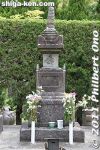
Grave of Azai Sukemasa (1491-1542) at Tokushoji temple in Nagahama, Shiga. He was the first lord of Odani Castle. 浅井亮政の墓 長浜市徳勝寺
|
|

Grave of Azai Hisamasa (1526-1573) at Tokushoji temple in Nagahama, Shiga. He was the second lord of Odani Castle and father of Nagamasa. 浅井久政の墓 長浜市徳勝寺
|
|

At the gate to enter the graves of the 47 ronin, they sell incense sticks. 四十七士墓所の門
|
|
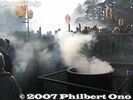
Incense burner
|
|

Large way going to the graves of the 47 ronin masterless samurai at Sengakuji temple. 四十七士墓所
|
|

Gishisai lanterns.
|
|

The graves all have headstones with the loyal retainer's name on it and age at death.
|
|

People buy incense sticks at the gravesite gate and place incense at all the graves.
|
|

On the Gishisai day or anniversary of the attack on Kira, there is an extra amount of people and incense smoke.
|
|

The smoke can kill all the bugs in your fur or wool coat.
|
|

Very thick smoke, but not suffocating. People with asthma or lung problems might want to avoid this.
|
|
|

Names are clearly written on wooden plaques.
|
|

Oishi Kuranosuke's grave
|
|

Soon after the 47 retainers committed seppuku on Feb. 4, 1703, they were buried here.
|
|
|

The gravestones all look alike. There is a map showing who is buried where.
|
|

Worshippers pile on the incense
|
|

Pile of incense in front of a grave.
|
|

From April 2015, Zojoji temple started allowing the public to view the Mausoleum of Tokugawa Shoguns.
|
|

This is the main entrance to the Tokugawa Shogun graves, but it is closed to the public. We entered through a smaller door.
|
|

Tokugawa family crest on the door.
|
|

This is the public entrance to the Tokugawa Shogun graves at Zojoji temple. Admission is 500 yen.
|
|

増上寺は、上野の寛永寺(霊廟非公開)と共に徳川家の菩提寺で、当山に埋葬されているのは、2代秀忠、5代将軍兄弟の綱重、6代家宣、7代家継、9代家重、12代家慶、14代家茂の6人の将軍の他、女性では将軍正室として2代秀忠夫人崇源院、6代家宣夫人天英院、11代家斉夫人広大院、13代家定夫人天親院、14代家茂夫人静寛院の5人、将軍の側室としては3代家光の桂昌院、6代家宣の月光院など5人、その他、将軍の子女を含む計38人であります。
|
|

Photos of the old and magnificent Mausoleum, similar to the one in Nikko.
|
|

Layout of Zojoji in the Meiji Period.
|
|

Here are photos of all the tombs going around the site in a clockwise direction. First is Goshi or a joint tomb. 合祀(ごうし)塔Entombed here are the wives and children of Tokugawa shoguns, including: 1. Tokugawa Tsunashige, a son of Shogun Tokugawa Iemitsu, 2. Keishōin, a concubine of Iemitsu and mother of Shogun Tokugawa Tsunayoshi, 3. Kodaiin, the wife of Shogun Tokugawa Ienari, 4. Gekkoin, a concubine of Tokugawa Ienobu and mother of Shogun Tokugawa Ietsugu.
|
|

Grave of Imperial Princess Kazunomiya (wife of Shogun Iemochi) who wanted to be next to her husband. 静寛院和宮
|
|
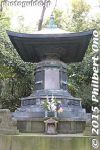
Tomb of Imperial Princess Kazunomiya
|
|

Grave of Shogun Tokugawa Iemochi 十四代家茂【昭徳院殿(しょうとくいんでん)】
|
|

Tomb of Shogun Tokugawa Iemochi
|
|

Tomb of Shogun Tokugawa Ienobu 六代家宣【文昭院殿(ぶんしょういんでん)】
|
|

Tomb of Shogun Tokugawa Hidetada and wife Go (Ogo). 二代秀忠【台徳院殿(たいとくいんでん)】お江
|
|

Tomb of Shogun Tokugawa Hidetada and wife Go (Ogo). The left sign indicates "Ogo" and right sign says, "Hidetada."
|
|

Tomb of Ogo, Hidetada's beloved wife.
|
|

Tomb of Shogun Tokugawa Hidetada
|
|

Three more Tokugawa tombs.
|
|

Tomb of Shogun Tokugawa Ietsugu 七代家継 【有章院殿(ゆうしょういんでん)】
|
|

Tomb of Shogun Tokugawa Ietsugu
|
|

Tomb of Shogun Tokugawa Ietsugu
|
|

Side view of Ieshige and Ieyoshi tombs.
|
|

Tomb of Shogun Tokugawa Ieshige 九代家重 【惇信院殿(じゅんしんいんでん)】
|
|

Tomb of Shogun Tokugawa Ieshige
|
|

Tomb of Shogun Tokugawa Ieyoshi 十二代家慶 【慎徳院殿(しんとくいんでん)】
|
|

Tomb of Shogun Tokugawa Ieyoshi
|
|

Side view
|
|
|
|

Tomb in the Mausoleum of Tokugawa Shoguns before it was open for public viewing.
|
|
|
|
|
|
|
































































































